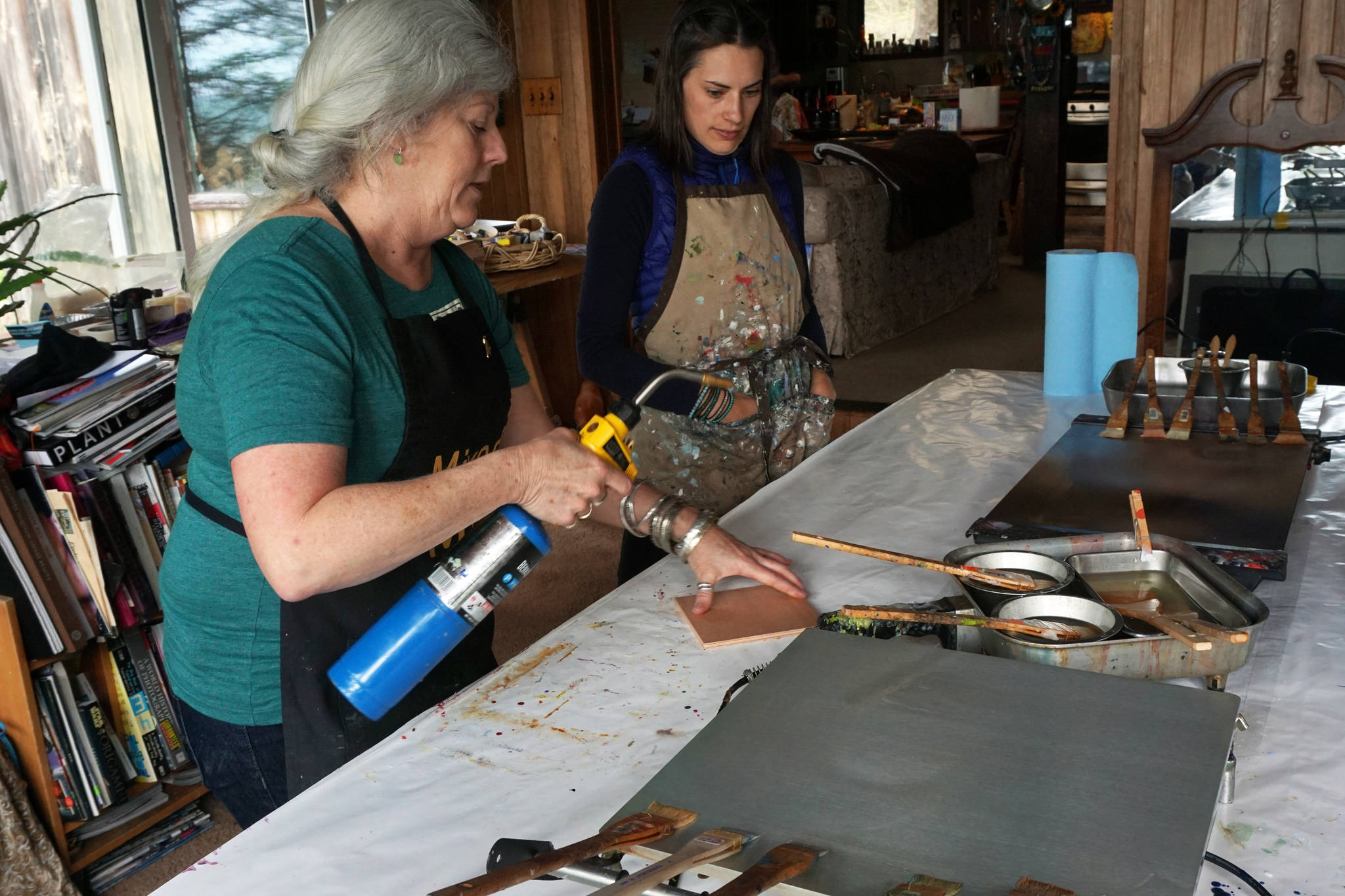On a cloudy Sunday last month, artist Ann-Margret Wimmerstedt brought together six student artists with one mission.
Feel the burn.
That’s the root of the word “encaustic” — “to burn,” a 2,500-year-old painting technique that uses colored wax to make paintings. Wimmerstedt, a board member of Bunnell Street Arts Center, held “Wine, Wax and Wimmerstedt,” a fundraiser for Bunnell that offered an afternoon’s instruction in encaustic painting with the bonus of a wine and appetizers break.
Wimmerstedt started in encaustic painting the same way, with a workshop at Bunnell in 2003. Since then she’s become part of a group of Homer artists who paint, print, melt, torch and carve with wax. Although the tools and supplies can be sophisticated and spendy, the basic equipment includes:
• Beeswax and a medium made of beeswax and damar, a plant resin that makes the medium harder;
• Encaustic pigments;
• Plywood to paint on;
• Electric heating pans or plates to melt and mix wax and pigment on;
• Brushes to paint with,
• Carving tools to score the wax, and
• Blow torches or heat guns to set and manipulate the wax.
In her home studio, Wimmerstedt set up a long table covered with heavy wax paper. She had two flat encaustic heating pans, the palette of the technique. Just as an artist painting in oil will have a wood palette to mix colors, in encaustic the hot pan is used to mix the wax pigments. Encaustic medium is used to extend the life of the pigments. Brushes resting on the flat heating pans keep the brushes flexible. Several thrift-store frying pans kept tubs of beeswax and medium fluid. Encaustic painters on a budget can use old electric pans as their palette. Crock pots work for making medium, a formula of 7 parts beeswax to one part damar.
Wimmerstedt also had propane blow torches handy to melt and set the wax. Heat guns could be used, but with six students working, that would blow the circuits in her house, she said. Fumes from encaustic wax can be toxic, so Wimmerstedt set the temperature low to minimize the gases. Painting should be done in well ventilated areas or under exhaust hoods. Oh, and because things can get a bit hot, she also had handy several fire extinguishers.
“It’s a little play day,” Wimmerstedt said in getting her students started. “I want you to do it.”
Like oil painting, encaustics starts with prepping the canvas. Because the wax can get heavy and hard, stretched canvas won’t work. Wimmerstedt had cut up some 6-inch square pieces of quarter-inch plywood. Any thick wood will do.
Wimmerstedt started with a coat of beeswax that gets fused with the blow torch. The base coat creates a good surface to paint on with the pigmented wax — or gooped on, layer upon layer sometimes.
“I like the texture, but I like the super smooth feel,” Wimmerstedt said. “Wax likes to build up.”
Each time a coat or layer goes on, out comes the blowtorch to fuse the wax.
“You don’t want your paint to leave the painting,” she said.
One trick Wimmerstedt taught used masking tape to keep the wax on the wood, a little ledge around it. Some artists like to paint layer upon layer, with different colors.
“It kind of sinks into the other layers,” Wimmerstedt said.
Using the blowtorch, the top layers can be melted away to reveal colors underneath. Sometimes the wax melts, and colors dribble together, creating new patterns.
“When it’s hot, things come up from underneath,” Wimmerstedt said. “It gets kind of crazy.”
Left to cool, the wax also can be carved or even sculpted. Painting with thick wax, it can be hard to draw straight lines or other shapes, but with a carving tool, that becomes easier. A line can be carved and then the gouge filled in with another color of wax.
“It’s like carving stone or marble,” Wimmerstedt said.
Some artists at the workshop used heated tin tin cans to make circles in the wax. One artist, Jane Bernard, used an oval-shaped gouge to make the shapes of flower petals. Bernard, visiting from Morgan City, La., took the class with her daughter, Mandy Bernard, a Homer artist. The class also included another visitor, Jeanette Mahoney of Longview, Wash., who heard about the class at a Bunnell First Friday opening.
Even the blobs of melted pigment on the hot palette can become art.
After the artists finished with a set of colors, Wimmerstedt took a piece of paper and laid it down on the hot wax.
It picked up the colors and became another technique of encaustic painting, a monoprint. That’s a technique that one of Homer’s preeminent encaustic artists, Kathy Smith, has perfected.
Encaustic also can be used with collage. Some students put feathers and twigs in their paintings. Photocopy prints or even magazine pages can be rubbed onto wax by burnishing with a spoon.
Wet the paper and rub it away, and the ink sticks to the wax.
Despite the trickiness of painting with wax, it’s also a forgiving medium. A lot of happy mistakes result, where the artist might not have intended something, but it looks pretty cool anyway.
“You’re fighting against what wax wants to do,” Wimmerstedt said.
But sometimes when the wax wins, the victory turns out well for everyone. If the painting doesn’t turn out to the artist’s desire, “You can scrape off your painting,” Wimmerstedt said. “There are no mistakes in encaustics.”
Michael Armstrong can be reached at michael.armstrong@homernews.com.


